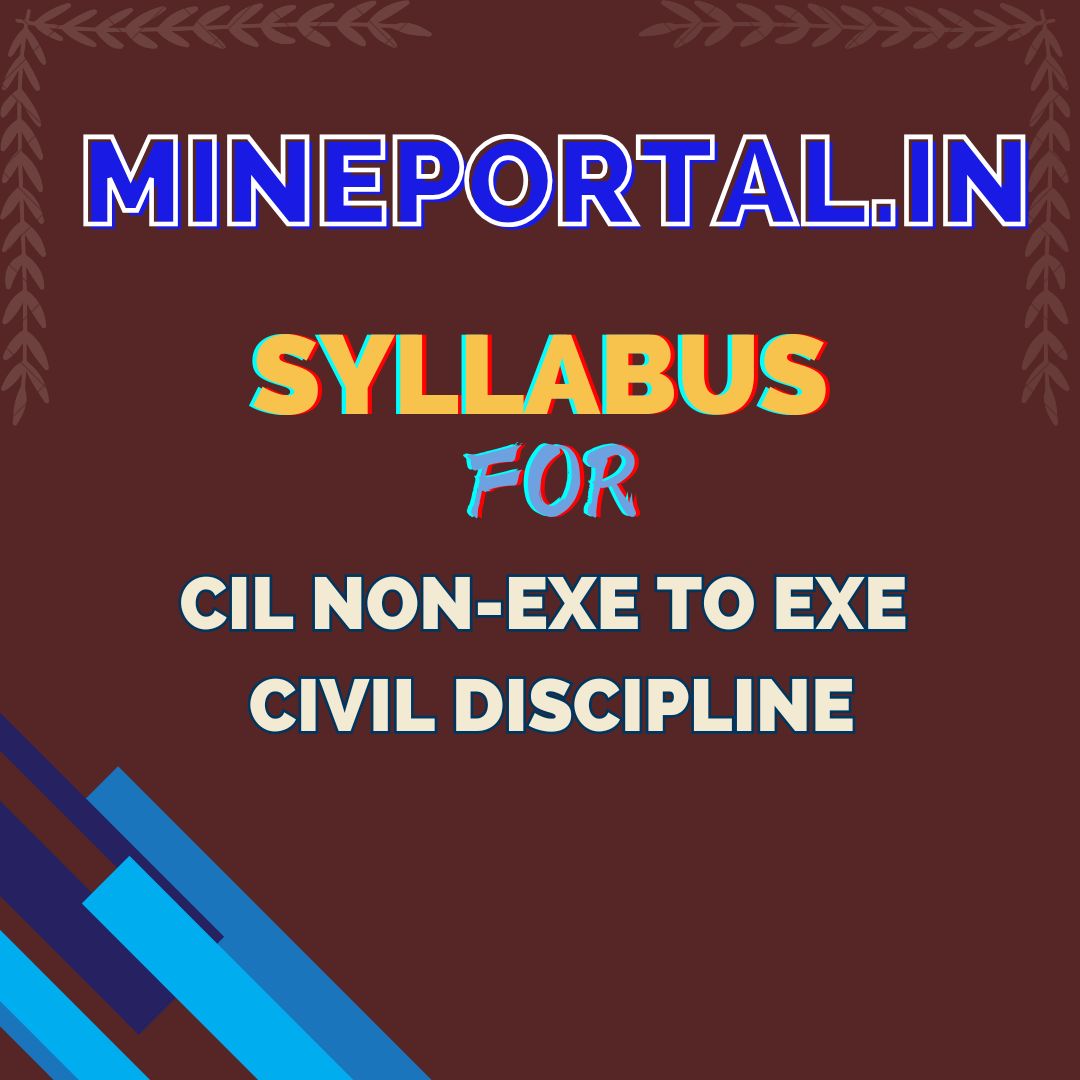
CIL NON-EXE TO EXE CIVIL DISCIPLINE EXAM SYLLABUS
COAL INDIA LTD NON-EXECUTIVE TO EXECUTIVE EXAM CIVIL DISCIPLINE SYLLABUS
1. Soil mechanics and foundation engineering - Basic Knowledge on the subject,
Fundamental definition & Inter relationship-(i) Vold Ratio (ii) Porosity (iii) Degree of saturation (iv) Bulk
Density (v) Dry Density (vi) Submerged density (vi) specific gravity (vii) Moisture content
- Index Properties- Grain size distribution from sieve analysis and Hydrometer test, the Atterberg Limits (Liquid Limit, Plastic Limit, Shrinkage Limit), Plasticity Index, IS classification based on grain size
- Shear strength of soil- Linear relationship of shear stress with cohesion, friction and normal stress. General, punching & local shear failure
- Settlement of shallow foundation- Immediate & consolidation settlement for sand and clay for a single layer soil under vertical load
- Bearing capacity: Different Terminologies
2. Engineering Mechanics, Strength of Materials & Analysis of Structure - Basic knowledge on the subject,
simple numerical.
Fundamental Definition( qualitative/quantitative)-(i) Force (ii) Moment(iii)Center of gravity(iv)
Moment of inertia(v) Bending Moment(vi) Shear Force(vii) torsion (viii) Elasticity (ix) stress
(x) strain (xi) Fixed Support (xii) Hinged Support (xiii) roller Support
- Parallelogram law forces, resolution of forces
- Bending moment, shear force-Single span with different types of support at ends and with UDL, concentrated Load, Diagrams
- Deflection pattern -Single span having different types of support at ends and with UDL & concentrated load.
3. Design of structures - Basic knowledge on the subject, simple numerical
- Loads - Different types of Loads (Dead Load, Live Load, Wind Load, Seismic Load etc.), Calculation of dead load for residential / office buildings from floor and masonry, Provision of 15-875 (Table-1, part-2) for live load of different facilities, parameters of wind load (section 5 of 15-875(part-3), Earthquake zones and zonal factors (IS 1893(part-1)-2002, table 2 & Annex E)
- Fundamental definitions: 1) column, i) Beam, lii) Stab, iv) Truss, v) Space Frame
- RCC Design: What is RCC, Why RCC is used, Design of RCC Singly reinforced beam with the help of
SP-16: Design of axially loaded column (Clause 39.3 of IS 456-2000), Design of slab (the relevant
table-Annexure D, Table-26 of IS 456-2000/SP16). Basic knowledge on Compressive and Tensile
zones, cover, Neutral Axis, Effective depth, Moment of resistance, Under reinforced, over reinforced,
doubly reinforced sections, one way and 2-way slab, Development length, control of deflection (CL 23.2
and 24.1 of IS-456).
- Detailing of RCC Structures - Clause 26.5 of IS-456 regarding Requirements of Reinforcement for Structural members, provisions of SP-34 (Handbook on concrete reinforcement and detailing).
- Design of Steel Structure-Basic knowledge on design of Tension member, compression member and flexural (bending) member (Refer IS 800-1984 & SP6), Welded Joint.
4. Public Health Engineering - Knowledge on important features of water supply system, water and sewage
treatment, waste water management.
5. Surveying - Basic Knowledge of the Subject & relevant IS codes.
6. Construction Practice - Basic Knowledge on the Subject & relevant IS codes.
- Mensuration - calculation of area and volume of different 2 dimensional and 3 dimensional figures.
- Concrete Technology - characteristic and permissible strengths of concrete and reinforcement, different nominal mix proportions, basic knowledge about design mix, material requirement for different grades of concrete, water cement ratio, the salient features of section 2, IS 456-2000 regarding materials, workmanship, inspection and testing with respect to cement(cl 5.1), aggregates (cl 5.3), water (cl 5.4), admixture (cl 5.5), reinforcement (cl. 5.6), concrete (cl. 6), workability of concrete (cl. 7), Table-5, Table-9, formwork (cl. 11), assembly of reinforcement (cl. 12), Transporting, placing compaction and curing (cl. 13), Sampling and strength of designed concrete mix (cl. 15).
- Construction of Steel structure.
- Construction of Brick masonry structure.
- Quality Control - Material Testing.
- Construction of Roads and pavement.
- Site Supervision/Monitoring
7. Rate analysis, Estimation & Measurement - Knowledge of Schedule of Rates being adopted in CIL
circulated vide Circular for Standardization of SOR, various relevant IS Codes (including IS 1200), knowledge on preparation of estimates for various works, analysis of rates as per standards of CPWD, preparation of Deviation Estimates, Revised Estimates, etc.
8. Basics of CIL Manuals, e-procurement and Contract Management - Knowledge on important features of Civil Engineering Manual, Manual for e-procurement of Works and Services, basic procurement policies.
9. Basic Level of ERP - About SAP MM Module, Basics of Contract, Purchase Requisition, Purchase Order,
Service Entry Sheets, Service Master, etc.


No comments added yet!